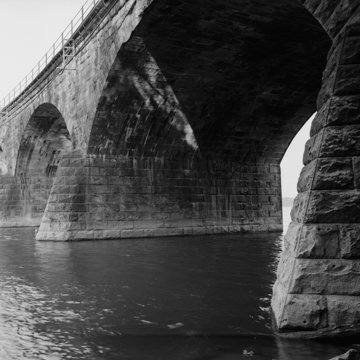A testament to the might of railroading in Pennsylvania and now a National Civil Engineering Landmark, the Rockville Bridge across the Susquehanna River was the longest masonry arch bridge in the world when completed. Prior to its construction, the Pennsylvania Railroad crossed the Susquehanna River on a wooden Howe truss bridge (1847–1849), followed in turn by a double-track iron bridge (1877). In order to increase the number of tracks, the railroad's chief engineer William Brown designed this bridge on an unprecedented scale: 52 feet wide with 48 ashlar masonry arches each spanning 70 feet for a total length of 3,820 feet. The commission was divided between two Philadelphia contractors, the eastern half awarded to Drake and Stratton and the west to H. S. Kerbaugh. Made of concrete and sandstone from quarries in Johnstown and Curwensville, the bridge was built by Italian stonemasons and Irish laborers in two years.
You are here
Rockville Bridge
1900–1902, William H. Brown, engineer; Drake and Stratton and H. S. Kerbaugh, builders. 0.5 miles south of Marysville
If SAH Archipedia has been useful to you, please consider supporting it.
SAH Archipedia tells the story of the United States through its buildings, landscapes, and cities. This freely available resource empowers the public with authoritative knowledge that deepens their understanding and appreciation of the built environment. But the Society of Architectural Historians, which created SAH Archipedia with University of Virginia Press, needs your support to maintain the high-caliber research, writing, photography, cartography, editing, design, and programming that make SAH Archipedia a trusted online resource available to all who value the history of place, heritage tourism, and learning.


